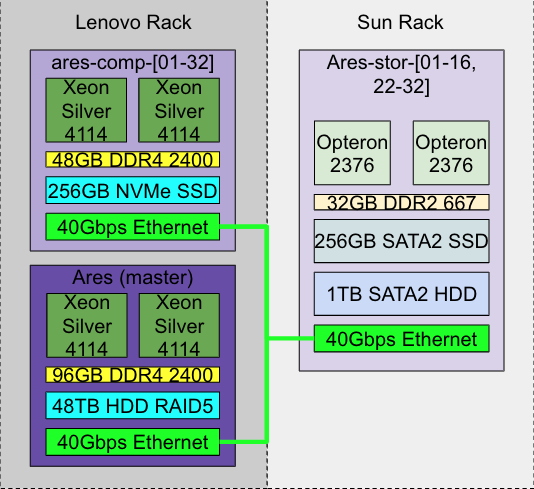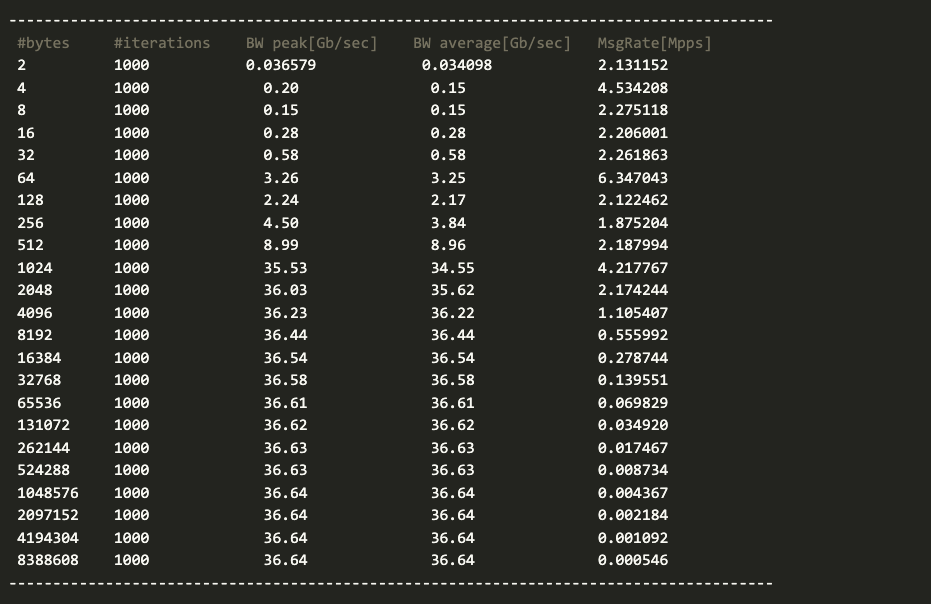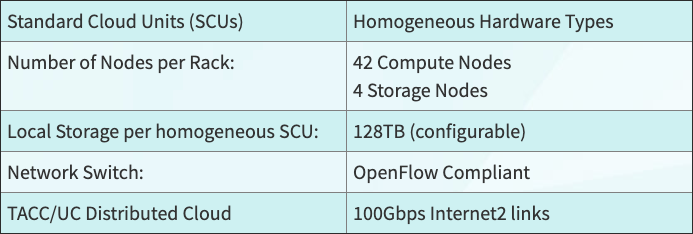Examples
Ares (IIT)


Compute Rack | Interconnect | Storage Rack |
|---|---|---|
8x C1 nodes w/ Samsung 960 Evo 250GB NVMe SSD |
|
|
24x C2 nodes w/ Toshiba OCZ RD400 256GB NVMe SSD |
- What kind of CPU(s)?
- Intel Xeon silver 4114
- How much memory and what kind?
- 128GB DDR4-2400 (need to double check)
- What's the OS? (kernel version, etc.)
- OpenHPC(GCC 4.8.5) on login and compute nodes, CentOS(GCC 7.3.0) and on storage nodes. (Need to double check)
- How is the system configured? (file systems, networking, etc.)
- All nodes are equipped with one Mellanox 40Gbps adapter.
- Each compute/storage node has one high-speed (40Gbps) Ethernet and one low-speed (1Gbps) Ethernet.
- Compute node 31, 32 and the master node are connected to the high-speed switch in the storage rack.
- Compute and storage nodes are connected to different switches which are connected with a 200Gbps uplink.
- The network speed on the storage nodes are limited by the PCIe 2.0 standard, which is around 1GB/s.
- OrangeFS 2.9.7 has been installed into /opt/ohpc/pub/orangefs. Every user can run it and access it from MPI applications with proper configuration in the MPI library.
Performance
Memory
RDMA max bandwidth is around 37 Gb/s.

Memory bandwidth (STREAM benchmark):
Memory latency (TLB benchmark):
- Huge/regular page seq: 7ns
- Huge page rand: 92 ns
- Regular page rand: 108 ns
- numbers are from
Storage
Disk bandwidth (fio benchmark):
- Compute node (Samsung
NVMe)
& Compute node (Toshiba
NVMe):
- Read max: 2.5GB/s
- Write max: 1GB/s
- Storage node (Samsung SATA SSD) with PICe
adapter
- Read/Write max: 400MB/s
- Storage node (Samsung SATA)
HDD
- Read/Write max: 180MB/s
Networking
| Direction | Latency (us) | Max Bandwidth (Gb/s) |
|---|---|---|
| Compute - compute node | 2 | 37 |
| Compute - storage node | 6 | 10 |
| Storage - storage node | 5 | 12.5 |
Chameleon (TACC)
The Chameleon architecture consists of a set of standard cloud units (SCUs).

Standard Cloud Units
- What kind of CPU(s)?
- Each compute node is with 24 cores delivered in dual socket Intel Xeon E5-2670 v3 “Haswell” processors (each with 12 cores @ 2.3GHz)
- How much memory and what kind?
- 128 GiB of DDR4 RAM.
- What's the OS? (kernel version, etc.)
- OS is configurable by the user.
- How is the system configured? (file systems, networking, etc.)
- Every switch in the research network is a fully OpenFlow compliant programmable Dell S6000-ON switch.
- Each node connects to this network at 10 Gbps, and each unit uplinks with 40Gbps per rack to the Chameleon core network.
- The core switches (Dell S6000-ON) are connected by 40 Gbps Ethernet links, which connect to the backbone 100Gbps services at both UC and TACC.
- Chameleon also provides a shared storage system. The shared storage provides more than 3.6PB of raw disk.
- Heterogeneous Compute Hardware
- The heterogeneous hardware includes various technologies: GPU and FPGA accelerators, SSD and NVMe storage, low-power ARM, Atom, and Xeon systems-on-a-chip.
- The two storage hierarchy nodes have been designed to enable experiments using multiple layers of caching: they are configured with 512 GiB of memory, two Intel P3700 NVMe of 2 TB each, four Intel S3610 SSDs of 1.6 TB each, and four 15K SAS HDDs of 600 GB each.
Tier Characterization
A tier is a class of storage devices that share certain characteristics including:
| Symbol | Description | Unit | Comment |
|---|---|---|---|
| L | Latency | ns | How is it measured? |
| B | Bandwidth | GB/s | How is it measured? |
| C | Total capacity | GB | |
| Q | Request queue depth | n/a |
The previous characteristics are considered constant during a Hermes session. In addition, the following time-dependent characteristics are considered:
| Symbol | Description | Unit | Comment |
|---|---|---|---|
| R | Remaining capacity | GB | |
| F | Request queue fill | % |
To keep the terminology simple, we will refer to the storage devices of a certain tier class collectively as "the tier."
Tiers are (pairwise) disjoint, i.e., no storage device can belong to more than one tier.
There are intra-tier and inter-tier connections (i.e., between tiers via suitable buses or interconnects). Data transfer via these connections may or may not require CPU intervention.
The grouping of storage devices into tiers has nothing to do with the physical distribution of the devices. For example, the fact that two storage devices are of RAM-class doesn't say anything about their "proximity", which is defined by the intra-tier connectivity.
Layer (Level?)
In Hermes, it is intuitive to define the "storage device distance" of a storage device from an application or permanent storage port, and storage devices can be ranked or sorted by their distance from such a port. By grouping together storage devices of the same or similar distance from a given port, one can identify layers or levels. The distance is defined relative to a port: The storage world "looks" different from different ports, i.e., the same storage device will generally have different distances from different ports. Since some of the storage device characteristics which enter into the storage device distance are time-dependent, the corrsponding layer structure is time-dependent as well!